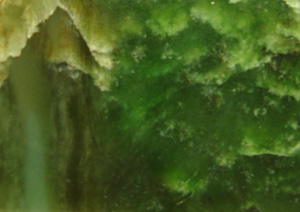Bowenite is the state mineral of Rhode Island:
"Bowenite, a serpentine mineral, a close relation of Jade and can be considered a semi-precious stone. It is found in the Northern part of Rhode Island in association with Limestone and is found in different colors; light yellow, canary yellow, light and dark green, gray and blue. It was discovered in the early 1800's by a Rhode Island geologist, George Bowen, and named in his honor....."
"......The most-common variety of serpentine in the gem trade is bowenite, the hardest of the serpentine minerals. It is a massive variety of antigorite that ranges from blue-green to green and green to yellow. It is translucent to semi-translucent, and has been used in various types of jewelry, as well as in decorative and ornamental applications."
http://www.ereferencedesk.com/resour...d/mineral.html
This particular raw specimen was collected by a friend of my wife's father many years ago, at the Conklin Limestone Quarry, in Lincoln, RI. It is an exceptional specimen, due to the deepness of the green color. If cut and polished, it would make a stunning specimen. I have heard, but never confirmed, that bannerstones from the Midwest have been found that were made of RI Bowenite. It is found in the same neck of the woods where Conklin jasper was sourced prehistorically, so it does seem likely the natives were aware of this gemmy mineral. And perhaps it was traded far afield from RI. This specimen has nice translucency, even given its thickness......
"Bowenite, a serpentine mineral, a close relation of Jade and can be considered a semi-precious stone. It is found in the Northern part of Rhode Island in association with Limestone and is found in different colors; light yellow, canary yellow, light and dark green, gray and blue. It was discovered in the early 1800's by a Rhode Island geologist, George Bowen, and named in his honor....."
"......The most-common variety of serpentine in the gem trade is bowenite, the hardest of the serpentine minerals. It is a massive variety of antigorite that ranges from blue-green to green and green to yellow. It is translucent to semi-translucent, and has been used in various types of jewelry, as well as in decorative and ornamental applications."
http://www.ereferencedesk.com/resour...d/mineral.html
This particular raw specimen was collected by a friend of my wife's father many years ago, at the Conklin Limestone Quarry, in Lincoln, RI. It is an exceptional specimen, due to the deepness of the green color. If cut and polished, it would make a stunning specimen. I have heard, but never confirmed, that bannerstones from the Midwest have been found that were made of RI Bowenite. It is found in the same neck of the woods where Conklin jasper was sourced prehistorically, so it does seem likely the natives were aware of this gemmy mineral. And perhaps it was traded far afield from RI. This specimen has nice translucency, even given its thickness......



Comment